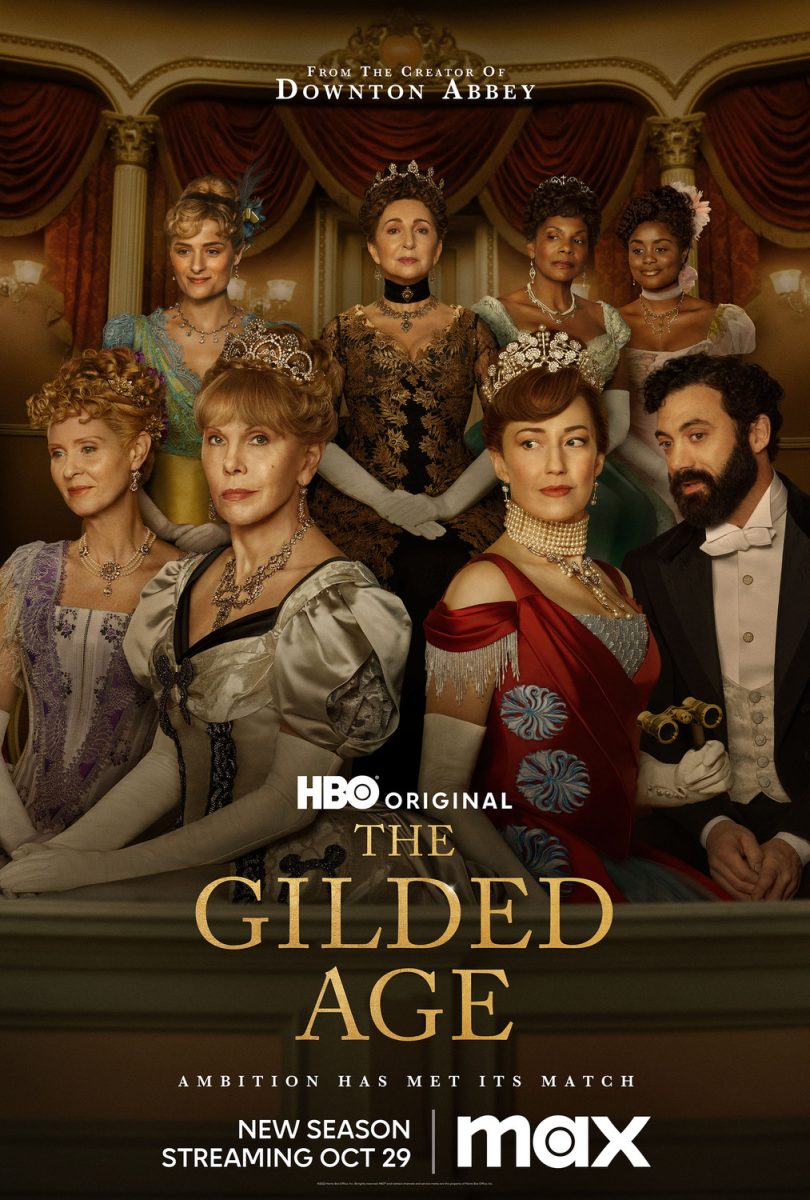Monopolies. Wealth. The Rockefellers. Growing prosperity and urbanization is the defining characteristic of the Gilded Age. But what about the other not-so-shiny side of that gilded coin? HBO’s “The Gilded Age” doesn’t flip over the coin to that other side very much, and in my opinion, for its purposes, that’s alright.
Season one of “The Gilded Age” follows Miss Marian Brooks, a bright, ingenue type character, just after her father dies and leaves her without any shiny, gilded coins to sustain herself. As a result of her penniless status, she moves with her aunts to New York City. It is hinted that one aunt, Agnes Van Rhijin, endured an abusive relationship with her now dead husband in order to provide for the family. Her other aunt, Miss Ada Brooks, is not unmarried and remains at the beck and call of the harsh and quick-witted Agnes, which makes for an interesting and complicated sibling dynamic. Miss Brooks goes to New York with Miss Peggy Scott, a black up-and-coming journalist she meets at the train station, who is then employed as Mrs. Van Rhijin’s secretary and eventually as a journalist at a black-operated newsroom called The Globe.
“The Gilded Age” also skillfully incorporates several storylines into the main artery that is upholding the show. Viewers may recognize this style from “Downton Abbey”, and they should. “Downton Abbey” writer Julian Fellowes, a true renaissance man (with actor, novelist, House of Lords Member, and TV writer under his belt), is the creator of both “Downton Abbey” and “The Gilded Age”. I agree that “The Gilded Age” may never likely live up to the success, both economically and creatively, of Downton, but that is because that is Fellowes’ magnum opus. This does not mean “The Gilded Age” is not good in its own right, and I find it spectacular.
Contrary to my expert opinions in period dramas and movies, critics at the New York Times and Vanity Fair alike have dubbed “The Gilded Age” as either a knock-off “Downton Abbey” or simply just “okay.” I disagree. “The Gilded Age,” just from its name, cannot function as an “eh” show. The time period it takes place in requires that it be oozing with opulent east coast mansions and frivolous silks and laces. I do agree with pop culture writer Kaiya Shunyata’s review to a certain extent. I’ll admit, “The Gilded Age’s” topics can seem vacuous at first glance, but the catty drama pulls you in while also interweaving history within the vapid arguments. Also, it cannot go unacknowledged that showing the sheer wealth of what essentially was the American aristocracy of “The Gilded Age” puts history into perspective, especially as this season explores the birth of the new-money Metropolitan Opera and how that clashed with the Academy’s old-money crowd. And if one doesn’t want to think from a historical viewpoint, there is enough romance, lies and ethical dilemmas to satisfy their entertainment cravings. Just watching wealthy people be wealthy does this in general. Society has always wanted to peer behind the satin curtains at lives of prestigious and mysterious luxury that eludes them in reality. Just as the wealthy in this show have too much money, I have too many reasons that attest to my love of this show, so I’ll focus on the big five.
- Costumes and Architecture
The visuals of this show are astonishing. When the characters go out to big events in the town, such as watching the fireworks as the Brooklyn Bridge is unveiled, the audience is blessed with entrancing skyline shots. The scenes contrast with the dirt roads and horse and buggies, showing how New York became the concrete jungle it is today. Additionally, viewers see the Metropolitan Opera house’s first night, and it is bustling with old-money and new-money attendees, complete with an English Duke as guest of honor. It is absolutely gorgeous. Also, throughout the season viewers can see full shots of the Russell’s palace like mansion, which is done on purpose to juxtapose with the dull and drab living conditions of the workers going on strike at the Russell’s railway business. Social commentary is skillfully combined with artistic appreciation viewers can have at the fact that, at one point in time, these magnificent structures existed. Although these shots may be CGI, and while I do feel that part of me registered this, I was too distracted imagining myself being at these historical moments and structures to care enough to notice.
Moreover, the costumes. The dress and jewelry are elaborate and simply awe-inspiring, particularly for Miss Brooks, Mrs. Russell and her daughter Gladys, who do the most socializing throughout the show. The Met Gala has nothing on these costumes. I think the show’s costume designer, Kasia Walicka Maimone, deserves much more public acknowledgment than she is receiving. With costumes and architecture considered, one can see how “The Gilded Age” lives up to its name.
2. Praise of escapism
The show meshes a wonderful form of escapism while making you feel like you are rooting for the underdog, despite the “underdog” in this case being uber-wealthy. One key element of Mrs. Russell’s plotline is that she is the new girl on the block. She constantly fights for a place at the 20-long-seat dining table with those who have had generational wealth. She is insecure, and desperately desires to be accepted, either by kindness or by force. When she doesn’t get her way being nice and requesting a box at the Academy, she makes her own, which becomes the Metropolitan. For the whole second season, she is engaged in a battle of money, wits and marketing with Lady Astor, the ringleader of the old-money population and the key patron of the Academy. As we all know, the Metropolitan came out on top.
With entertainment rooted in history, I feel that it is important that the storytelling is done skillfully since the viewers already know the inevitable outcome. “The Gilded Age” accomplishes this beyond what I expected. As Russell experiences the setbacks that jeopardize her work, such as her duke being “stolen” from her (which she also stole from her maid turned wife of a rich man), we see her claw her way at the top. Her methods are at times morally gray. She does as far as pimping out her daughter to the Duke by eluding that he may be able to marry her in order to win his attendance. This goes to show her desperation. In the end, she just wants acceptance and friends who will welcome her to her social circle. She feels left out, and that’s something all viewers can relate to. While most viewers cannot relate to her from a financial standpoint, viewers are rooting for her every step of the way because of how they connect to her experiences. Although the boxing fight of the Academy vs. The Met does not seem high stakes to us, viewers get so engrossed in it. Nail-biting conflicts ensue as we wonder “How is Mrs. Russell going to get out of this one?” and then we applaud as she undoubtedly finds a way out. It provides a wonderful weekend-night one hour long period of escape into her problems from our real, and at times, more grueling ones.
3. Attack on tropes
A main attack on the art that is “The Gilded Age” is that it is basic and predictable, especially the characters. I don’t beg, but demand to differ. In the first season, I did have a problem with Ada Brook’s character, since I felt that she was a one-faceted character bound by “the spinster” trope. To my surprise, she was put in a new light this season. She falls in love and marries Reverend Luke Forte despite her demanding sister’s dissent. She is not the weak and docile person we thought her to be in the first season, and the second season shows her coming into her own. Not only does she gain confidence and esteem, but she comes to fiscal prominence as well, even surpassing her older sister. Agnes used to hold her late husband’s fortune over Ada’s head, since she, as the provider and a married woman, was the matriarch. Unfortunately, Ada only experiences brief happiness. Her husband soon dies of cancer, but unexpectedly leaves her a fortune he inherited from a relative. He did not tap into it during his lifetime, since, as a reverend, he rejected materialism. This comes just in time as Agnes’s son Oscar gets swindled by a beautiful con artist into a bad investment, and leaves Agnes with only modest, yet not destitute, means. Ada is now hailed as the lady of the house. The servants look for her greenlight, instead of Agnes’, because they know she is the one who will pay them. The tables do turn on this family and hopefully lead to more character development.
4. Unique Social commentary is adequate
The show covers a variety of unique social situations. For example, one is an age gap relationship, but the way this is conducted is not typical for the media. Instead of the usual older man and the younger woman, this relationship occurs between a younger man and older woman, though she isn’t that old. Mrs. Susan Blane married an older, wealthier man when she was very young, but he lived longer than she expected. When Larry Russell, the Russell’s son, works on her house after her husband dies, the burgeoning architect and new widow engage in a fling. While the relationship was originally without meaning, the two fall in love with each other. To save her son socially, Mrs. Russell forces Mrs. Blane to end the relationship. She essentially tells Mrs. Blane that she needs to end it now, because the relationship has no where to go. Marriage is not a viable option for them. Mrs. Blane breaks it off and both parties are left heartbroken. The relationship examines how both people fell in love, but it was a “right person, wrong time” situation, and we do feel hurt for Larry.
Additionally, the show, in my opinion, adequately addresses the racism and poverty of the time. This is done in Peggy Scott’s storyline. Miss Scott, who had never been to the South, travels with her editor to Alabama to do a story on the Tuskegee Institute and Booker T. Washington. She and her editor are almost killed by a white mob and hide out in a barn before they return to New York. The severity of the frightening scene serves as a wake-up call for both viewers and Miss Scott, being that this degree of violence had not appeared on the show before. Miss Scott had gone to Alabama against her mother’s wishes and warnings and was shocked at the more overt, and violent racism of the south in comparison to the north. Additionally, Miss Scott and Miss Brooks are also best friends throughout the show, and Miss Scott is close to the Van Rhijin family, but we do see racial barriers. At one point, Miss Scott cannot catch a cab with Miss Brooks. Also, Miss Brooks volunteers to speak as a teacher on behalf of black schools, which an all-white board unsuccessfully tries to shut down. These and several other examples highlight the racism of society during the Gilded Age, so one cannot argue that it goes ignored.
5. “The Gilded Age” does address the other side of the coin
One of the main focuses of this season was Mr. Russell’s status as a robber baron. He openly fights against a real-life union The Knights of Labor, led by the fictitious Bill Henderson. Mr. Russell’s character is not entirely innocent, but he does come around to their outrageous desire for an eight-hour work day. After visiting the working-class neighborhood of Henderson, he sees the poor living conditions and that Henderson works in his factory instead of attending school. This makes him reconsider being less of a robber baron than he is, but his main goal at the end of the day is profit. This shows the stark class divide of the Gilded Age and makes viewers feel conflicted. We love Russell as a character, but he is not the most generous person.
In conclusion, “The Gilded Age” is a lot deeper than most critics give it credit for. That being said, it does focus on the more affluent aspect of it, and that’s okay. The show is a great form of escapism and I firmly believe that not every single piece of media needs to be about atrocities, inequalities and injustices for it to be good. We need the truth just as much as we need la-la land, and “The Gilded Age” offers a nice serving of both.















Nita Tolman • Jan 23, 2024 at 10:11 am
One of the best shows on TV!!! Can’t wait for next season!!!
Sasha Cabral • Feb 6, 2024 at 11:35 am
Same here!